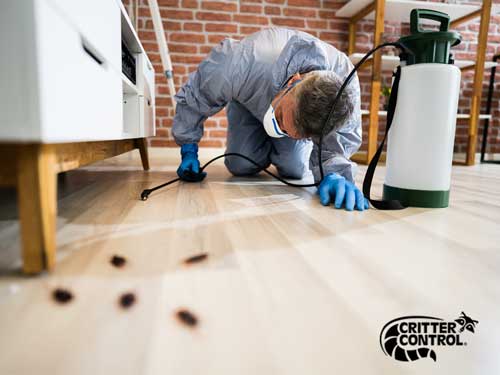Experienced A1 Exterminators Charlotte NC - Fast and Reliable Solutions
Experienced A1 Exterminators Charlotte NC - Fast and Reliable Solutions
Blog Article
Bed Pest Therapy Malfunction: Comparing Chemical Vs. Non-Chemical Solutions
In the realm of pest control, especially when managing the persistent problem of bed bugs, the selection in between chemical and non-chemical therapy remedies can be a crucial one. Both methods provide distinctive advantages and disadvantages, affecting elements such as performance, security factors to consider, and total price. By taking a look at the nuanced details of each technique, a more clear understanding of which path to seek in resolving a bed insect problem can be achieved.
Performance of Chemical Therapies
Chemical treatments for bed bug invasions have been commonly recognized for their rapid and potent effectiveness in eradicating these insects. When taking into consideration the performance of chemical therapies, it is essential to understand that they can supply a fast and complete solution to a bed pest trouble. Professional exterminators typically rely upon pesticides to target bed bugs at different stages of their life cycle, consisting of eggs, fairies, and grownups. These chemicals normally work by interfering with the bed insects' nerves, leading to paralysis and eventual fatality.
Additionally, chemical treatments have the benefit of offering recurring effects, suggesting that they can remain to eliminate bed pests even after the preliminary application. This residual activity is especially useful in combating any possible re-infestations. Furthermore, the quick action of chemical therapies can bring relief to people dealing with severe bed insect invasions, allowing them to regain control of their space quickly.
Safety And Security Issues With Chemical Solutions
One important facet that requires cautious factor to consider when making use of chemical services for bed insect treatment is making certain the safety and security of occupants and the environment. Direct exposure to certain chemicals used in bed pest therapies can lead to respiratory problems, skin irritability, or other unfavorable reactions, especially in individuals with pre-existing conditions or level of sensitivities.
Moreover, the environmental impact of chemical remedies is another substantial factor to consider. Some chemicals utilized in bed insect treatments might be damaging to helpful bugs, wild animals, and communities if they seep into the soil or water supply. It is essential to utilize chemical therapies judiciously, following safety and security standards, and considering less hazardous choices to mitigate these dangers and ensure the efficient and secure management of bed bug infestations.
Advantages of Non-Chemical Strategies
Considering the possible safety problems and environmental influence connected with chemical services for bed bug treatment, exploring non-chemical approaches provides an appealing alternative with numerous distinct advantages. Non-chemical approaches provide a much safer option for families, especially those with individuals, pets, or kids sensitive to extreme chemicals. These techniques get rid of the risks of direct exposure to hazardous compounds, reducing the possibility for adverse health and wellness impacts. Furthermore, non-chemical treatments are eco-friendly, as they do not add to index air or water air pollution, making them a lasting option for bug control.
In addition, non-chemical solutions can be reliable in targeting bed pests, consisting of hard-to-reach areas where chemical therapies may not pass through. Techniques such as warmth therapy, vacuuming, steam cleaning, and cushion encasements give extensive elimination without making use of hazardous chemicals. Moreover, non-chemical techniques can be less turbulent, needing minimal prep work and enabling quicker reentry into treated locations. On the whole, deciding for non-chemical bed pest treatment methods not just focuses on security and ecological defense however also ensures comprehensive and reliable pest control.
Limitations of Non-Chemical Treatments

Additionally, non-chemical therapies often require several applications to accomplish successful obliteration. This can be time-consuming and might not always assure complete removal of all bed pests and their eggs, specifically in hard-to-reach or concealed areas.
Additionally, the success of non-chemical Home Page treatments greatly relies upon correct application and thoroughness, which can be challenging for people without specialist experience. Inadequate application of non-chemical approaches may cause insufficient obliteration, leading to persistent infestations and the need for additional treatments.
For that reason, while non-chemical therapies have their advantages, it is crucial to acknowledge these limitations and consider them when identifying the most reliable strategy for taking care of bed pest invasions.
Expense Comparison: Chemical Vs. Non-Chemical Options
Offered the limitations linked with non-chemical treatments, a vital aspect to examine in the context of bed bug management is the cost contrast between chemical and non-chemical options. In contrast, non-chemical therapies like warm therapy or vapor can be more pricey, with expenses varying from $1,000 to $6,000 for an entire home. While the preliminary price of chemical treatments might appear lower, numerous treatments might be required to fully eradicate the problem, potentially boosting the total cost.
Final Thought

Thinking about the potential security problems and environmental impact connected with chemical options for bed pest treatment, exploring non-chemical techniques offers a promising option with several distinct advantages.Given the restrictions linked with non-chemical treatments, a crucial element to examine in the context of bed bug monitoring is the expense contrast in between chemical and non-chemical options. In contrast, non-chemical treatments like warm treatment or heavy steam can be a lot more pricey, with prices ranging from $1,000 to $6,000 for an termite inspection cost entire home. While the preliminary expense of chemical treatments may seem lower, several therapies might be required to completely remove the invasion, possibly raising the general expense.In final thought, when comparing chemical and non-chemical bed bug treatment alternatives, it is important to take into consideration effectiveness, security, advantages, constraints, and price.
Report this page